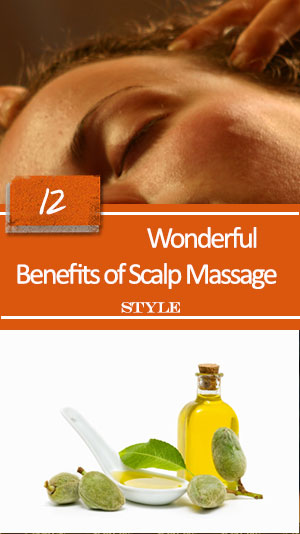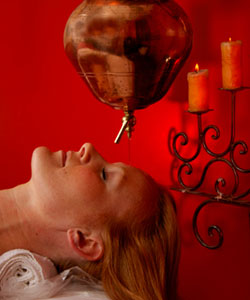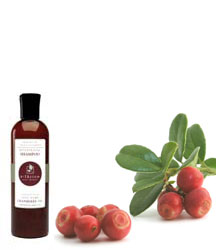12 Wonderful Benefits of Scalp Massage
According to ayurveda, a system of medicine founded in historical India, a healthy beautiful head of hair requires an ongoing care routine that starts with nourishment. Why wait until you experience hair problems? As with your skin, start taking care of it now and you'll reap the benefits for years to come.
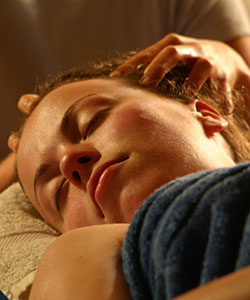
12 Benefits of Scalp Massage
A warm oil massage, done at least once a week (if you have more Vata in your make-up, you would want to try to do it two to three times a week), has the following benefits:
- It lubricates and conditions the scalp, helping to prevent flakes and dry scalp without the use of harsh chemical shampoos.
- It helps enhance blood circulation in the head and neck area. When the scalp is "tight" from stress, circulation and hair growth are impeded.
- It helps relax the scalp and increase pliability.
- It helps strengthen the roots of the hair and nourishes the hair-shafts, promoting new hair growth and strengthening current hair.
- It helps soften and condition the hair, making it more manageable.
- It spreads the natural oils of the hair, increasing hair lustre and vibrancy.
- It helps protect hair from the damaging effects of the sun and harsh weather by improving resiliency over time.
- It is replenishing and rejuvenating for dry, damaged hair, and helps prevent excessive brittleness and split-ends.
- It helps pacify Vata dosha. Especially when enriched with Vata-pacifying herbs, a warm oil hair and scalp massage can be wonderfully relaxing for the mind and nervous system.
- When fortified with cooling, Pitta-pacifying herbs, the hair and scalp massage can help balance Pitta dosha and help prevent Pitta-related problems such as premature graying or thinning of hair. It also helps reduce body heat in general, especially if you have been up late a few nights or your eyes are smarting from too much close work on the computer or reading. A Pitta-pacifying massage also helps promote emotional balance.
- The massage helps relax the muscles in the neck area.
- The hair and scalp massage can help promote sound sleep at night.
You not sure if you are a Vata, Pitta or Kapha? Take this quiz at the end of this article to find your answer.
Choosing a Massage Oil for Scalp
Massaging the scalp and hair with warm oil, preferably infused with hair-friendly herbs, is the best way to nourish the scalp and hair topically. Not only does the massage work wonders for your hair, but it also relaxes the mind and nervous system. The oil for the massage can be customized by hair and body type:
- Hair: If your hair is thin, dry and frizzy and prone to split-ends, you have Vata hair.
- Body: : If you have fine hair prone to premature thinning or graying, you are Pitta-predominant. If you are predominantly Kapha, your hair will tend to be thick and oily.
If you are Vata-predominant (that is, someone who has physical and mental qualities that reflect the elemental of Space and Air), choose almond oil (sweet) or sesame oil as the base oil. Both of these oils are very nourishing for the scalp and hair and help reduce stiffness and tightness in the scalp.
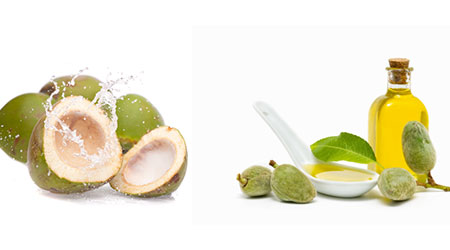
For Pitta persons (that is, someone who has physical and mental qualities that reflect the elemental of Fire and Water), cooling coconut oil is the ideal choice. Because coconut is very Pitta-pacifying, coconut oil massage can retard hair problems such as thinning and premature graying that are associated with an aggravated Pitta dosha.
If you are Kapha-predominant (someone who has the physical and mental qualities reflect the elemental of Earth and Water), sesame or olive oil are good choices. Olive oil has purifying properties that help keep pores open. While massaging with a dosha-appropriate base oil can be helpful, ayurvedic oils designed for hair and scalp massage typically include one or more hair-friendly herbs to augment the benefit of the massage.
Hair-friendly Herbs
Traditionally, these herbs are slow-cooked with the oil, and the oil is then strained and ready for use.
Brahmi helps calm the mind and nervous system, pacifies Vata and is very nourishing for the hair. It helps promote hair thickness and body.
Bhringaraj, which translates to "king of tresses," is also Pitta-pacifying and very nourishing for the hair. Hibiscus is cooling and helps maintain hair color and vitality.
Neem is good for Kapha hair; it has purifying and cleansing properties. Rosemary and Lavender are excellent for all types of hair.
Rosemary helps stimulate hair follicles and promotes growth, helps retard premature thinning and graying, and soothes and conditions the scalp.
Lavender stimulates hair growth, balances oil production and replenishes the hair and scalp.
Jasmine helps alleviate stress.
How to Do the Scalp and Hair Self-Massage
- Pour some oil into a bowl and warm the oil by placing the bowl in some hot water. The oil should be warm but comfortable to the touch.
- Using the pads of your fingers, apply the oil little by little to different parts of your scalp, parting your hair as needed. Also work some oil along the length of your hair.
- Then, using the pads of your fingers, work the oil into your scalp, using circular motions. Slow, deliberate movements are relaxing while steady but vigorous movement helps enhance energy and circulation.
- Cover your entire scalp, all the way down the sides to your ears and at the back to your neck.
- Leave the oil on for at least 30-60 minutes, longer if you can. If you like, you can dip a towel in hot water, wring it out, and wrap it around your head after your massage for added conditioning and softening of hair.
You can even leave the oil on overnight and place a thick towel over your pillow to protect your linens. Shampoo out with a gentle, natural shampoo.
Discover your Dosha
You not sure if you are a Vata, Pitta or Kapha? Take this quiz to determine your constitution

